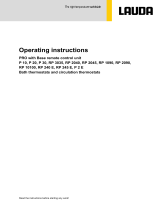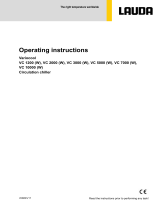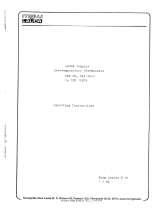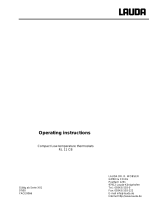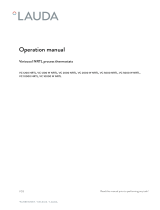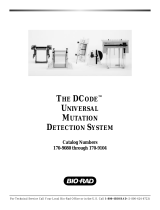Page is loading ...

Valid from series: 1
YAME0020 Version 01/04/09
LAUDA DR. R. WOBSER
GMBH & CO. KG
Postfach 1251
97912 Lauda-Königshofen
Germany
Phone: (+49) 09343/ 503-0
Fax: (+49) 09343/ 503-222
e-mail [email protected]
Internet http://www.lauda.de
Operating Instructions
PTT
Peltier Thermostating Unit
LMTZ 831

PTT
YAME0020 / 30.06.11 Contents 3
First some safety information
Before you operate the device, thoroughly read through all the instructions and
safety information in Section 1. If you have any queries, please feel free to call us.
Follow the instructions about siting, operation, etc., as only then can improper
handling of the device be eliminated and the full warranty coverage maintained.
The device is switched off using the toggle switch on the external power supply
unit.
The device and its internal parts can be damaged by:
- dropping
- vibration
The device may only be operated by appropriately instructed personnel.
Never operate the device without tempering liquid!
The operating instructions contain additional safety information which is identified with a triangle
with an exclamation mark . Read and follow the instructions. Ignoring the instructions can lead
to severe consequences, e.g. personal injury, damage to property or the device itself.
Technical modifications reserved.
Special symbols:
Be careful!
This sign is used when improper handling can lead to
property damage and/or personal injury.
Note:
Here, something in particular needs the reader's at-
tention. In certain circumstances this includes a note
about a hazard.
Reference
Refers to further information in other sections.

PTT
YAME0020 / 30.06.11 Contents 5
Table of contents
First some safety information ....................................................................................................... 3
1Safety information ............................................................................................................ 6
1.1General safety information ................................................................................................. 6
1.2Additional safety information .............................................................................................. 6
2Package contents ............................................................................................................. 7
3Device description ........................................................................................................... 8
3.1Basic principles .................................................................................................................. 8
3.2Temperature display and control ........................................................................................ 8
3.3Operating and functional controls ...................................................................................... 9
3.4Interfaces and sockets ..................................................................................................... 10
4Installation and operation ............................................................................................. 11
4.1Installation ........................................................................................................................ 11
4.2Operation ......................................................................................................................... 15
4.3Checking the filling level ................................................................................................... 16
4.4Switching off ..................................................................................................................... 16
4.5Standby mode .................................................................................................................. 16
5Technical data ................................................................................................................ 17
6Appendix ......................................................................................................................... 18
6.1Error messages ................................................................................................................ 18
6.2Ambient conditions ........................................................................................................... 18
6.3Materials ........................................................................................................................... 19
6.4Cleaning ........................................................................................................................... 19
6.5Repair information - service ............................................................................................. 20
6.6Accessories, replacement parts ....................................................................................... 21
7Index ................................................................................................................................ 22

PTT
6 Safety Information YAME0020 / 30.06.11
1 Safety information
1.1 General safety information
The PTT Peltier Thermostating Unit cools or heats tempering liquids and sample liquids. Hazards arise
from this due to high or low temperatures, fire and the general hazards due to the application of electri-
cal energy.
The user is extensively protected by the application of the relevant standards. Further hazard sources
can arise from the type of material for which the temperature is to be stabilised, e.g. by exceeding or
undercutting certain temperature thresholds or with the fracture of the sample liquid container and reac-
tion with the tempering liquid.
It is not feasible to include all possible situations. They remain essentially subject to the judgement and
responsibility of the operator.
The device may only be used as intended, that is as described in these operating instructions. This in-
cludes operation by instructed specialist personnel.
The device conforms to the EMC standard DIN EN 61326-1 Class A.
The device is not designed for use under medical conditions according to DIN EN 60601-1 or
IEC 601-1.
1.2 Additional safety information
Only connect the device to a mains socket having a safety earth conductor.
At higher operating temperatures parts of the beaker receptacle can take on surface temperatures
of over 70 °C. Be careful when touching the device. Danger of burns.
Withdraw the mains plug of the PTT unit before cleaning, servicing, or moving it.
Have repairs to the PTT carried out only by specialists.
Figures for temperature accuracy and display accuracy apply under normal conditions according to
DIN 12876.

PTT
YAME0020 / 30.06.11 Package contents 7
2 Package contents
After unpacking, first check the unit and accessories for any transport damage. If the de-
vice is found to be damaged, the haulage or postal company must be immediately in-
formed so that verification can take place. In this connection please inform the LAUDA
Service Centre or an authorised LAUDA representative.
Please check the package contents for completeness:
PTT Thermostating Unit Cover
Power supply unit Temperature sensor
Beaker 60 Filling syringe
Magnetic stirring rod 15 mm D 4.5 (This manual)

PTT
8 Device description YAME0020 / 30.06.11
3 Device description
3.1 Basic principles
3.2 Temperature display and control
The PTT Thermostating Unit facilitates the exact temperature stabilisation of small amounts of liquid up
to 60 ml from 5 °C to 80 °C.
The liquid can be stirred if required using an inserted magnetic stirring rod (included in the supplied
items).
For vibration-free measurement applications all electrical components (fans, magnetic stirrer, power
electronics for the thermostating unit) can be deactivated in the standby mode.
The PTT uses four Peltier elements spread uniformly around the circumference of the beaker. Heat is
supplied or extracted depending on the tempering situation. Ambient air enters the device through the
intake areas (ribbed regions at the front left and rear right), it circulates around the heat exchanger with-
in the device and leaves the device through the side exit areas.
In order to ensure perfect air circulation neither the ventilation openings nor the exit areas should be re-
stricted or covered.
The PTT is equipped with a protection system which safeguards the power electronics and Peltier ele-
ments from thermal overload.
A bimetallic switch fitted internally in the beaker receptacle provides additional protection from the con-
tainer overheating above 90 °C.
Measurements and setting values as well as operating statuses are displayed on the front of the PTT
using a 3-figure 7-segment display 888. The entry of the set value and other settings occurs using the
button/rotary function of the control knob.
The Pt100 temperature sensor for the acquisition of the momentary sample temperature is connected
via the "Sensor" socket. A high resolving A/D converter processes the measurement. Further measure-
ment processing occurs via a special control algorithm which implements the control of the Peltier elec-
tronic tempering system.
To measure the temperature of the samples reliably the Pt100 sensor must be immersed by at least
three millimetres in the sample liquid. With thermostating processes extended over a longer period the
reduction in level due to evaporation must be taken into account as necessary.
The liquid should be kept in motion by an inserted stirring rod in order to facilitate improved heat
transport and to ensure a uniform temperature throughout the whole liquid volume.

PTT
YAME0020/ 30.06.11 Device description
9
3.3 Operating and functional controls
All operating and functional controls on the PTT are situated at the front.
A 3-figure 7-segment display indicates the actual and set-point temperatures, the stirrer speed and error
messages.
Three LEDs positioned close to the display specify the figures shown in the display. Indicators located be-
low the display represent the operating statuses.
The control knob has rotary and button functions, the operation of which is described in Section 4.2.
6 7 8
1
2
3
4
5
1 Display (actual temperature, set-point temperature, set stirrer speed, error code)
2 Indicator for actual temperature ("°C")
3 Indicator for set-point temperature ("")
4 Indicator for rotational speed ("")
5 Control knob: Set-point adjustment by rotation; press to set the magnetic stirrer
6 Indicator for malfunction
7 Indicator for heating phase
8 Indicator for cooling phase

PTT
10 Device description YAME0020 / 30.06.11
3.4 Interfaces and sockets
The PTT is equipped as standard with the following interfaces and sockets:
- "Power" socket for connection to an external power supply unit
- "Sensor" socket for connection to an external Pt100 measurement probe
"Command" socket is actually not active
- USB socket (at the back and covered, only for servicing)

PTT
YAME0020 / 30.06.11 Installation and operation 11
4 Installation and operation
4.1 Installation
1. Site the Peltier unit on a firm, uncluttered surface. Maintain at least 6 centimetres spacing on all
sides (air access).
2. With the switch set to the "0" position, connect the power supply unit to the electrical mains
network (100...240 V) and connect the plug securely to the Peltier device ("Power").
3. Connect the temperature sensor to the Peltier device ("Sensor").
4. Fill the thermostatic block with 6...6.5 ml of tempering liquid using the filling syringe.
The thermostatic block should be sufficiently filled,
but not overfilled. Too little tempering liquid reduces the
heat transport and can lead to the system switching to
EMERGENCY OFF.
The devices are rated for operation with non-
flammable and flammable liquids according to DIN EN
61010-2-010. Watch the filling level.
Generally, decalcified water is used as the temper-
ing liquid. Please ensure that the evaporation rate re-
mains low, so that sufficient tempering liquid is always
available. Please note that with an unsuitable choice of
medium condensate interacts with the sample in your
beaker. Please ensure that your tempering liquid does
not interact with the thermostatic block (material: ano-
dised aluminium).

PTT
Installation and operation YAME0020 / 30.06.11
12
5. Fill the beaker with at least 40 ml of sample liquid and put it in place.
The minimum filling amount is 40 ml. It is only then that the immersion depth required by the tem-
perature sensor is ensured.
6. Place the filled sample beaker in the thermostatic block.
When the beaker is inserted, the
tempering liquid rises up the outer
wall of the beaker. The highest possi-
ble filling level is desirable for the
best possible heat transfer.
4.3 Checking the filling level
7. Insert the temperature sensor; if required use the stirring rod and put the cover in place.
The temperature sensor should
be immersed in the sample by at
least 3 millimetres. When inserting
the beaker, the tempering liquid
level should ideally rise up to
about 8 millimetres above the
standing surface of the beaker.
>3 mm

PTT
YAME0020 / 30.06.11 Installation and operation 13
8. The PTT is put into operation by actuating the switch ("On" = I). In the default setting the device
tempers the liquid to 25°C.
On starting, the device automatically carries out a self-test. All indicators on the front display
are activated for 2 seconds for checking purposes. The display indicates the current sample
temperature (LED "°C" is lit).
The set-point temperature is set by simply turning the control knob. The LED "" lights as long
as the figure for the set-point temperature is displayed.
Provided the user does not change the settings, the device operates with the standard values
TSET= 25 °C and = 0 (corresponds to deactivated stirrer). When working without a stirring rod,
the stirrer should remain deactivated. Stirrer activity is indicated by the flashing of the control
knob.
The device can be switched off a
t
any time by resetting the toggle switch.
Three seconds after entering a ne
w
set-
p
oint temperature, the curren
t
sample temperature is automaticall
y
displayed.
If an error code is indicated, please
refer to the appropriate section (
6.1).

PTT
Installation and operation YAME0020 / 30.06.11
14
9. Setting the speed of the magnetic stirrer occurs by briefly pressing the control knob: As long as
the LED "" (4) is lit, the speed can be adjusted by turning the knob (steps 1...9). Stirrer activity
is indicated by the flashing of the control knob.
The magnetic stirrer is switched off by pressing the control knob again (step 0).
Three seconds after entering a
new speed, the current sample
temperature is automatically dis
-
played again.
Three LEDs indicate the three operating statuses "Malfunction", "Heating" and "Cooling":
Malfunction Heating Cooling
With "Malfunction" please note the error code indicated in the display, switch off the device at the
power supply unit and refer to the error messages. ( 6.1).

PTT
YAME0020 / 30.06.11 Installation and operation 15
4.2 Operation
The PTT Peltier Thermostating Unit can be easily operated due to the intuitive one-knob operation and
clear visual feedback.
Standard situation (after switch-on and in operation)
New settings are automatically accepted after approx. 3 seconds and the device then resets to the adapted
standard operating situation.
Display corresponds to ACTUAL temperature
Heating phase / Cooling phase
Magnetic stirrer
activated / deactivated
Flashes during
stirrer operation
Set-point tem-
perature is
being set:
0...80 °C
Stirrer speed is being
set;
Display:
1 (slow) … 9 (fast)
(ERROR)

PTT
Installation and operation YAME0020 / 30.06.11
16
4.3 Checking the filling level
The optimum amount of tempering liquid is
6.5 ml. With an insufficient filling level for the
tempering liquid it can be topped up even with
the beaker in place. To do this the required
amount of tempering liquid is introduced
through the filling hole using the filling syringe.
It is desirable to have a sufficiently high
filling level of tempering liquid for the best
possible heat transfer.
With longer tempering processes visually
check the filling level.
4.4 Switching off
● The PTT can be switched off at any time by actuating the
switch ("Off" = O).
4.5 Standby mode
The PTT can be put into a standby mode. To do this the control knob is held pressed for at least 3 se-
conds.
In this way all electrical components (fans, magnetic stirrer, power electronics for the thermostating unit)
are deactivated.
The standby function is used for periods in which the beaker is removed from the system (e.g. when
changing the sample liquid) or for (measurement) phases which require a vibration-free environment.
The device must be put into the standby mode when the temperature sensor is out of the
sample liquid for longer than two minutes in order to prevent overheating of the system and
triggering of the EMERGENCY-OFF function.
Return to the operating mode occurs by again pressing the control knob for at least three seconds.

PTT
YAME0020 / 30.06.11 Technical Data 17
5 Technical data
PTT Series A
Operating temperature °C 5...80
Ambient temperature °C 10...40
Relative humidity % 40…60
Temperature for storage °C - 10…50
Setting resolution °C 0.1
Display resolution °C 0.1
Temperature accuracy K ± 0.1
Cooling output @ 25 °C W 10
Overall size W x D x H mm 125 x 150 x 100
Stirring steps 0 (deactivated) 1…9
Weight kg 1.1
Type of protection to DIN EN 60529 IP 21
Power consumption W 100
Technical modifications reserved.
Heating and cooling curves
Heating curve
Sample: water, 50 ml
Transmitter medium: water; cover
25
30
35
40
45
50
55
60
65
70
0510
Time, min
Cooling curve
Sample: water, 50 ml
Transmitter medium water; cover
5
10
15
20
25
0 5 10 15
Time, min
Technical modifications reserved.
Heating and cooling curves; bath closed; tempering liquid water; Tamb=21 °C; t [min], T [°C].

PTT
18 Appendix YAME0020 / 30.06.11
6 Appendix
6.1 Error messages
The Self-Check Assistant of your PTT
Thermostating Unit monitors numerous
device parameters and issues error mes-
sages, if necessary.
All messages are indicated in the display
using error codes which are interpreted
according to the error list and can be rem-
edied as required.
Message Meaning Remedy
Er.0 Memory error, parameter Report to LAUDA Service
Er.1 Memory error, hardware Report to LAUDA Service
Er.2 Sensor not connected Connect sensor to PTT unit
Er.3 Internal T-sensor defective Check immersion depth of external sensor
Er.4 Fault on Command supply Report to LAUDA Service
Er.5 Power stage overload Report to LAUDA Service
Er.6 Driver overheating Report to LAUDA Service
Er.7 Undervoltage for power driver Report to LAUDA Service
Er.8 Difference, T-sensors Report to LAUDA Service
Er.9 Fan problem Report to LAUDA Service
To protect the unit against overheating it is equipped with a bimetallic protection device. This device
completely isolates the unit from the power supply when the temperature of the receiving container ex-
ceeds 90 °C. In this case please contact the Service Department.
6.2 Ambient conditions
The use of the thermostating unit is only admissible under the conditions stated in DIN EN
61010-2-010:2003 and DIN EN 61010-1:2001.
The device may be set-up and operated only indoors.
Place on a sealed, flat, non-slip and non-flammable siting base.
For proper operation it is essential to conform to the ambient temperature requirement (refer
to Technical data).
Relative humidity (refer to Technical data).
Overvoltage Category II and transient overvoltages according to Category II.

PTT
YAME0020 / 30.06.11 Appendix 19
6.3 Materials
The bath which comes into contact with the tempering liquid consists of anodised aluminium. A
tempering liquid compatible with the material is decalcified water.
The black cover plate is manufactured from tempered moulded material similar to PP/ABS. The
material is thermally stable up to 130 °C.
The cover panels fitted to the sides are manufactured from material similar to ABS.
The transparent top cover consists of PX522HT, temperature-resistant up to 110 °C.
Damage to the device due to the use of liquids, which can modify the above mentioned ma-
terials, is in no case covered by the warranty from LAUDA Dr. R. Wobser GmbH & Co KG.
The resulting damage can on no account be rectified free of charge.
6.4 Cleaning
Cleaning can be carried out with water with a few drops of a surfactant (washing-up liquid) added
and with the aid of a damp cloth.
Withdraw the mains plug before cleaning
the device. It is essential to avoid the in-
gress of water into the ventilation slots and
the sockets.
Be careful when using the device in the
TD 3 Tensiometer: No residues of wash-
ing-up liquid should enter the measuring
beaker.

PTT
20 Appendix YAME0020 / 30.06.11
6.5 Repair information - service
Withdraw the mains plug before all servicing and repair work.
Have repairs carried out only by specialists.
When sending in a device, please ensure that it is carefully and properly packed. LAUDA cannot
be held liable for any damage due to improper packing.
If you want to send in a device for repair, it is essential to first consult the
LAUDA Instrument Service SMG or an authorised representative.
When ordering replacement parts, please state the type of device and number on the rating label on
the rear panel. This avoids queries and erroneous shipment.
The serial number is composed as follows, e.g. LMT850-09-0001
LMT850 = Article number
09 = Year of manufacture 2009
0001 = Incremental numeration.
Your contact for maintenance and expert service support:
LAUDA Instrument Service SMG
Phone:
+49 (0)9343/ 503-148 Mr. Stastny (Techn. Support)
+49 (0)9343/ 503-128 Ms. Brömel (Support)
For queries, ideas and critique:
LAUDA DR. R. WOBSER GMBH & CO. KG
Postfach 1251
97912 Lauda-Königshofen
Germany
Phone: 0049 (0)9343/ 503-0
Fax: +49 (0)9343/ 503-222
e-mail: [email protected]
Internet: http://www.lauda.de
/



